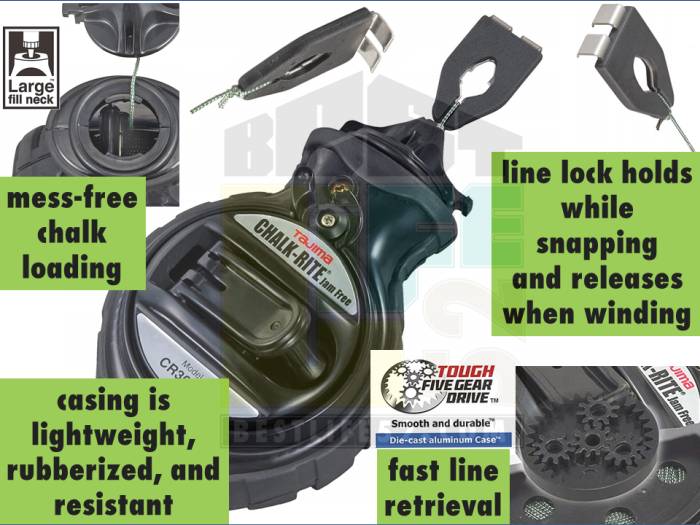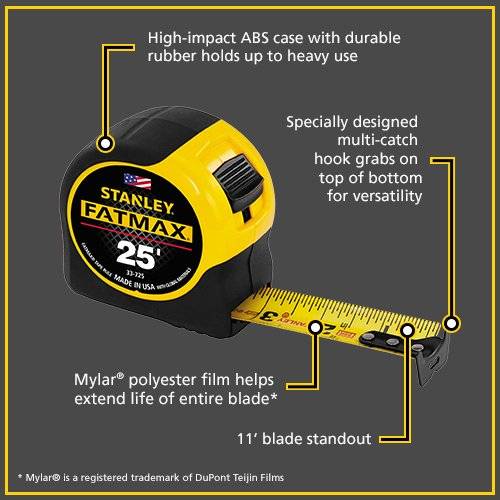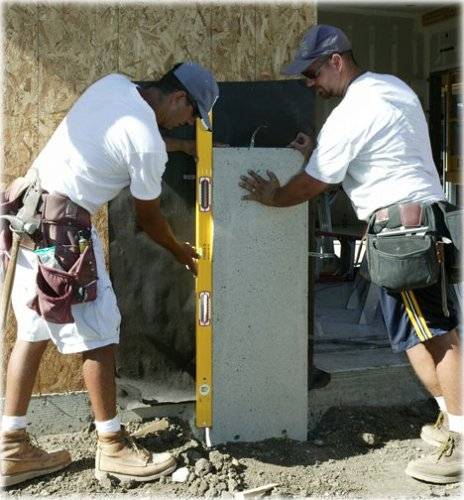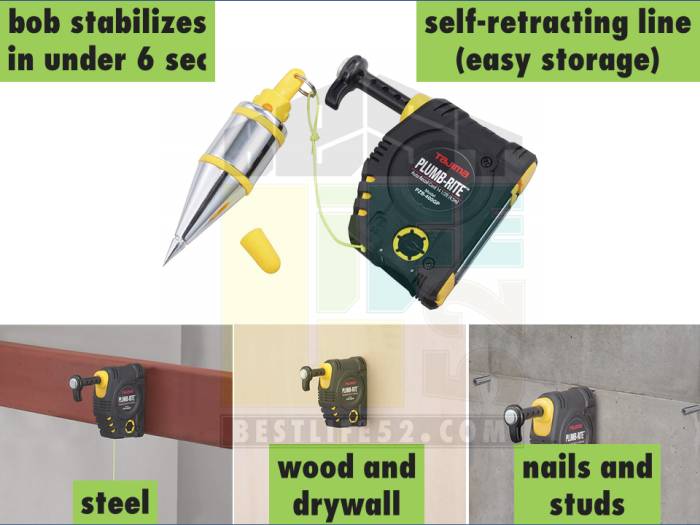6 Hacks for finding Straight, Square, Plumb, and Level
Avoid problems by starting properly
There you stand, frustrated and disappointed, in the middle of your half-finished basement. Your dream family room has turned into a nightmare. Beautiful oak doors stick and bind; that last row of floor tiles tapers from 4 in. on one end down to 1 in. on the other; none of the drywall fits quite right; and now, standing ankle deep in wasted oak trim, you wonder where you went wrong.
Well, chances are, it was at the very start, with lumber that wasn’t straight, corners that weren’t square, and a floor that wasn’t level.
Benefits
Starting off straight, square, level, and plumb (vertical) is the most crucial step in assuring that your projects turn out looking great. The little extra time spent up front will pay off handsomely all along the way, with less wasted material, fewer hours spent on the job, and a lot less frustration.
Here are detailed instructions at how to do it.
Is it straight?
Wood performs amazing contortions as it dries, so be picky when you buy your lumber. If it’s too crooked, nothing built with it, on it, or next to it will fit well.
Is my lumber straight?
Selecting high-quality material is the first step toward projects that are straight and true. Sight along the edges to check. You can always fix things with a jointer and a planer.

The naked eye is as good a tool as any when it comes to judging crooked vs. straight. You can detect a hump, or “crown.” as it is called by carpenters, by sighting along the length of a board (Photo). A slight crown is almost inevitable, but you should reject boards where it is very noticeable.
When building a wall, have all the crowns on the same side, so the finished wall doesn’t have a wavy surface. With floor joists, a small crown is actually desirable —just make certain you always position the crown up. A joist with a 1/2-in. upward crown will wind up straight if the center settles 1/2 in. A joist with a 1/2-in. downward crown will wind up with a full 1-in. sag after the same amount of settling.
How to check if a wall is straight?
Stretch a string between blocks at each end of the wall. Measure the gap between the test block and string.

A string pulled taut is a good way to check straightness. For instance, to see if a wall is straight, tack two spacer blocks of the same thickness at the ends of the wall and stretch a string between the two (Photo 6). By measuring between the string and wall at intermediate points, you can determine how far to push the wall in or out to straighten it. This is a great way to align fence and deck posts, check for sags in floors, or level the grid for a suspended ceiling.
Snapping a line
When you need to mark a long, straight line on a wall, ceiling or floor, use a chalk line (see Photo 3). Secure the hook end; reel out the string and pull it taut; then lift the string straight up and let it go.
The Tajima Chalk-Rite CR301JF is a jam-free snap line chalk box. The snap line is extra-bold. Line retrieval has 5 gears to save your time on your jobsite. The ABS case is lightweight and rubberized for better grip. The large fill neck makes loading easy and mess-free. Click here to see Amazon customer reviews.
Is it square?
Is my cabinet square?
Check the diagonal measurements and adjust your work until they are equal. The cabinet will then be square.
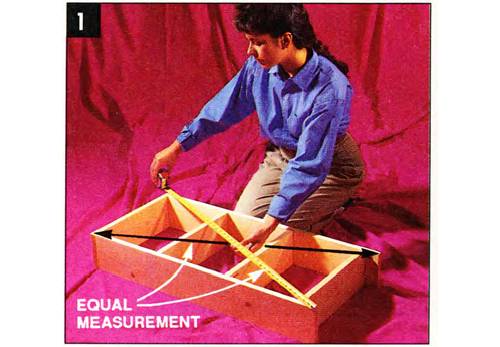
By comparing diagonal measurements (Photo 1) and adjusting accordingly, a person can square up a wall, cabinet door, window — really, any rectangle or square. The diagonal measurements will be equal when the comers are square.
The Stanley FatMax 33-725 is super resistant against drops. The first 3 feet of the tape rule are reinforced for better durability; the entire blade has a polyester film. It has 16-inch and 19.2-inch stud center markings to simplify any framing jobs. The spring is heat-treated for a longer life and smooth recoil. Stanley gives a limited lifetime warranty, too. Click here for Amazon customer reviews.
Are my walls square?
Make marks 3 ft. along one wall, 4 ft. along the other; then adjust until the diagonal measurement is 5 ft.
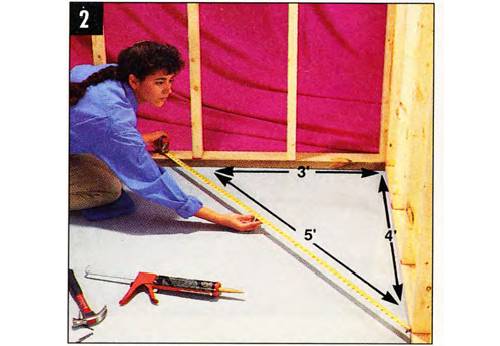
Whether you’re building a birdhouse or a skyscraper, you can check whether comers are square by using the 3-4-5 rule: A triangle with sides of 3, 4 and 5 will form a 90-degree corner. It doesn’t matter whether the measurements are inches, feet or light-years. or whether it’s multiples like 6, 8, 10, or 30, 40, 50 — the corner will always be exactly 90 degrees. The 3-4-5 technique is especially useful for large structures like walls (Photo 2), the framing of a deck, or fence comers.
What is the difference between level and plumb?
“Level” simply means parallel to the earth’s surface; “plumb” means perpendicular to this, or straight up and down.
Is my floor level?
Use a long, straight board to extend the working length of levels and to span small dips and irregularities.
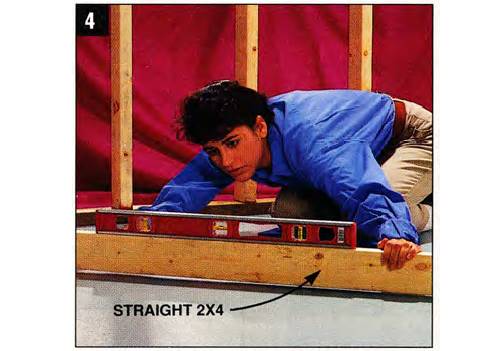
Most levels contain three glass vials: ones at each end indicating plumb and one in the middle indicating level. When the bubble is exactly centered between the two lines on the vial. your work is plumb or level — provided your level is accurate.
To test a level’s accuracy, place it on a flat surface and note where the bubble lies in relationship to the centering lines. Tum the level end for end and check if the bubble maintains exactly the same position. Some metal levels can be adjusted. Vials in wood levels can be removed and reputtied, but it’s an art — consult the level manufacturer.
Crowned or bowed lumber will give your level a false reading, so when checking the corner of a wall or a door opening for plumb. take two or three readings along the length of the stud to obtain an average.
The Stabila 37424 is a construction level with German accuracy. The frame is wide and strong. The end caps are made of rubber and removable for flush measuring. There are readings on the top and bottom. Click here to read Amazon reviews.
Is my pipe at the right slope?
Determine the correct 1/4-in. drop per foot by placing 1 in. of blocking under the end of a 4-ft. level.
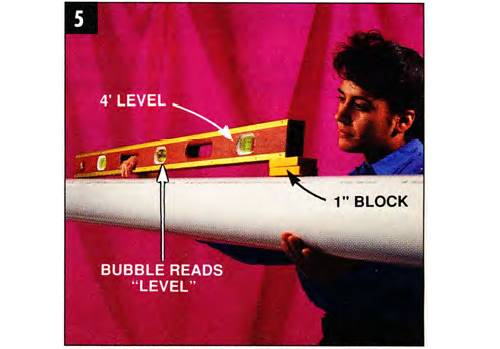
Using a plumb bob
The plumb bob, a string with a pointed weight on one end, is another way of establishing true vertical.
A level is more convenient to use when truing up walls, but plumb bobs shine when it comes to transferring marks from a higher to a lower point — for example, to center a wood stove directly beneath a chimney or to position ceiling fins or lights.
The only hard part about using a plumb bob is waiting for it to stop spinning and swaying before you can transfer your mark.
The Tajima Plumb-Rite PZB-400GP has a quick stabilizing bob (under 6 seconds). You can connect it to wood and drywall with a pin, to steel with a magnet, or to nails and studs with a hook. The line is self-retracting for easy storage. Click here to read Amazon customer reviews.
Most chalk line boxes, with their tapered bodies and centered string holes, can serve double duty as plumb bobs (Photo 3).
Is my location directly overhead? How to check if a wall is plumb?
Use a chalk line box or plumb box to transfer locations (like this chimney pipe) up or down.
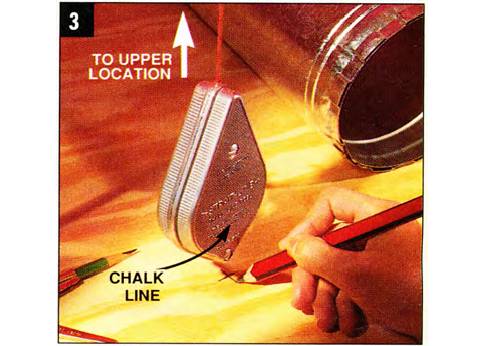
Avoid problems by starting properly
There you stand, frustrated and disappointed, in the middle of your half-finished basement. Your dream family room has turned into a nightmare. Beautiful oak doors stick and bind; that last row of floor tiles tapers from 4 in. on one end down to 1 in. on the other; none of the drywall fits quite right; and now, standing ankle deep in wasted oak trim, you wonder where you went wrong.
Well, chances are, it was at the very start, with lumber that wasn’t straight, corners that weren’t square, and a floor that wasn’t level.
Benefits
Starting off straight, square, level, and plumb (vertical) is the most crucial step in assuring that your projects turn out looking great. The little extra time spent up front will pay off handsomely all along the way, with less wasted material, fewer hours spent on the job, and a lot less frustration.
Here are detailed instructions at how to do it.
Is it straight?
Wood performs amazing contortions as it dries, so be picky when you buy your lumber. If it’s too crooked, nothing built with it, on it, or next to it will fit well.
Is my lumber straight?
Selecting high-quality material is the first step toward projects that are straight and true. Sight along the edges to check. You can always fix things with a jointer and a planer.

The naked eye is as good a tool as any when it comes to judging crooked vs. straight. You can detect a hump, or “crown.” as it is called by carpenters, by sighting along the length of a board (Photo). A slight crown is almost inevitable, but you should reject boards where it is very noticeable.
When building a wall, have all the crowns on the same side, so the finished wall doesn’t have a wavy surface. With floor joists, a small crown is actually desirable —just make certain you always position the crown up. A joist with a 1/2-in. upward crown will wind up straight if the center settles 1/2 in. A joist with a 1/2-in. downward crown will wind up with a full 1-in. sag after the same amount of settling.
How to check if a wall is straight?
Stretch a string between blocks at each end of the wall. Measure the gap between the test block and string.

A string pulled taut is a good way to check straightness. For instance, to see if a wall is straight, tack two spacer blocks of the same thickness at the ends of the wall and stretch a string between the two (Photo 6). By measuring between the string and wall at intermediate points, you can determine how far to push the wall in or out to straighten it. This is a great way to align fence and deck posts, check for sags in floors, or level the grid for a suspended ceiling.
Snapping a line
When you need to mark a long, straight line on a wall, ceiling or floor, use a chalk line (see Photo 3). Secure the hook end; reel out the string and pull it taut; then lift the string straight up and let it go.
The Tajima Chalk-Rite CR301JF is a jam-free snap line chalk box. The snap line is extra-bold. Line retrieval has 5 gears to save your time on your jobsite. The ABS case is lightweight and rubberized for better grip. The large fill neck makes loading easy and mess-free. Click here to see Amazon customer reviews.
Is it square?
Is my cabinet square?
Check the diagonal measurements and adjust your work until they are equal. The cabinet will then be square.

By comparing diagonal measurements (Photo 1) and adjusting accordingly, a person can square up a wall, cabinet door, window — really, any rectangle or square. The diagonal measurements will be equal when the comers are square.
The Stanley FatMax 33-725 is super resistant against drops. The first 3 feet of the tape rule are reinforced for better durability; the entire blade has a polyester film. It has 16-inch and 19.2-inch stud center markings to simplify any framing jobs. The spring is heat-treated for a longer life and smooth recoil. Stanley gives a limited lifetime warranty, too. Click here for Amazon customer reviews.
Are my walls square?
Make marks 3 ft. along one wall, 4 ft. along the other; then adjust until the diagonal measurement is 5 ft.

Whether you’re building a birdhouse or a skyscraper, you can check whether comers are square by using the 3-4-5 rule: A triangle with sides of 3, 4 and 5 will form a 90-degree corner. It doesn’t matter whether the measurements are inches, feet or light-years. or whether it’s multiples like 6, 8, 10, or 30, 40, 50 — the corner will always be exactly 90 degrees. The 3-4-5 technique is especially useful for large structures like walls (Photo 2), the framing of a deck, or fence comers.
What is the difference between level and plumb?
“Level” simply means parallel to the earth’s surface; “plumb” means perpendicular to this, or straight up and down.
Is my floor level?
Use a long, straight board to extend the working length of levels and to span small dips and irregularities.

Most levels contain three glass vials: ones at each end indicating plumb and one in the middle indicating level. When the bubble is exactly centered between the two lines on the vial. your work is plumb or level — provided your level is accurate.
To test a level’s accuracy, place it on a flat surface and note where the bubble lies in relationship to the centering lines. Tum the level end for end and check if the bubble maintains exactly the same position. Some metal levels can be adjusted. Vials in wood levels can be removed and reputtied, but it’s an art — consult the level manufacturer.
Crowned or bowed lumber will give your level a false reading, so when checking the corner of a wall or a door opening for plumb. take two or three readings along the length of the stud to obtain an average.
The Stabila 37424 is a construction level with German accuracy. The frame is wide and strong. The end caps are made of rubber and removable for flush measuring. There are readings on the top and bottom. Click here to read Amazon reviews.
Is my pipe at the right slope?
Determine the correct 1/4-in. drop per foot by placing 1 in. of blocking under the end of a 4-ft. level.

Using a plumb bob
The plumb bob, a string with a pointed weight on one end, is another way of establishing true vertical.
A level is more convenient to use when truing up walls, but plumb bobs shine when it comes to transferring marks from a higher to a lower point — for example, to center a wood stove directly beneath a chimney or to position ceiling fins or lights.
The only hard part about using a plumb bob is waiting for it to stop spinning and swaying before you can transfer your mark.
The Tajima Plumb-Rite PZB-400GP has a quick stabilizing bob (under 6 seconds). You can connect it to wood and drywall with a pin, to steel with a magnet, or to nails and studs with a hook. The line is self-retracting for easy storage. Click here to read Amazon customer reviews.
Most chalk line boxes, with their tapered bodies and centered string holes, can serve double duty as plumb bobs (Photo 3).
Is my location directly overhead? How to check if a wall is plumb?
Use a chalk line box or plumb box to transfer locations (like this chimney pipe) up or down.


